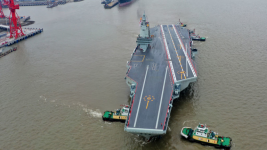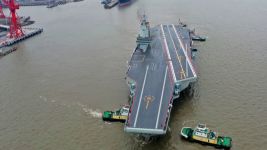- Jan 25, 2024
- 111,083
- 353
The People's Liberation Army Navy(also known as People's Navy, Chinese Navy, or PLA Navy) is the maritime service branch of the People's Liberation Army, and the largest navy per number of ships in the world.
The PLAN traces its lineage to naval units fighting during the Chinese Civil War and was established on 23 April 1949.
Until the late 1980s, the PLAN was largely a riverine and littoral force (brown-water navy). In the 1990s, following the fall of the Soviet Union and a shift towards a more forward-oriented foreign and security policy, the leaders of the Chinese military were freed from worrying overland border disputes. Traditionally subordinated to the PLA Ground Force, PLAN leaders were now able to advocate for renewed attention toward the seas.
Chinese military officials have outlined plans to operate in the first and second island chains, and have worked towards blue water capability.[8] Chinese strategists talk about the development of the PLAN from a green-water navy into "a regional blue-water defensive and offensive navy."[9] As the PLAN has expanded into a blue-water navy, regular exercises and naval patrols have increased in the South China Sea within the Nine-dash line, the Senkaku Islands/Diaoyutai in the East China Sea, and the island of Taiwan, which it all claims as its territory.
The People's Republic of China (PRC) along with the Republic of China (ROC), Vietnam, Brunei, Malaysia, and the Philippines claims a significant amount of maritime boundary located within the South China Sea. Some exercises and patrols of the PLA NAVY in recent years went as close as the coastline of Japan, Taiwan, and Alaska within their EEZ although undisputed territorial waters have been not been crossed except in cases of innocent passage.
The PLAN traces its lineage to naval units fighting during the Chinese Civil War and was established on 23 April 1949.
Until the late 1980s, the PLAN was largely a riverine and littoral force (brown-water navy). In the 1990s, following the fall of the Soviet Union and a shift towards a more forward-oriented foreign and security policy, the leaders of the Chinese military were freed from worrying overland border disputes. Traditionally subordinated to the PLA Ground Force, PLAN leaders were now able to advocate for renewed attention toward the seas.
Chinese military officials have outlined plans to operate in the first and second island chains, and have worked towards blue water capability.[8] Chinese strategists talk about the development of the PLAN from a green-water navy into "a regional blue-water defensive and offensive navy."[9] As the PLAN has expanded into a blue-water navy, regular exercises and naval patrols have increased in the South China Sea within the Nine-dash line, the Senkaku Islands/Diaoyutai in the East China Sea, and the island of Taiwan, which it all claims as its territory.
The People's Republic of China (PRC) along with the Republic of China (ROC), Vietnam, Brunei, Malaysia, and the Philippines claims a significant amount of maritime boundary located within the South China Sea. Some exercises and patrols of the PLA NAVY in recent years went as close as the coastline of Japan, Taiwan, and Alaska within their EEZ although undisputed territorial waters have been not been crossed except in cases of innocent passage.























